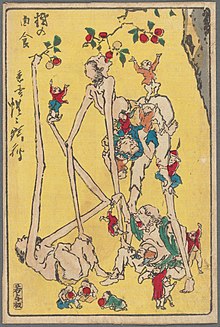Our teams have been busy installing this show-stopping 17-metre-long theatre curtain ahead of our #MangaExhibition opening later this month!
It was made by Japanese artist Kawanabe Kyōsai for the Shintomi Theatre on 30 June 1880. That day, after drinking a few bottles of rice wine, Kyōsai retreated to a studio and started painting. Just four hours later he emerged with the huge curtain, depicting members of the acting company as various kinds of monsters 👹👺
The curtain is on loan from the Tsubouchi Memorial Theatre Museum, Waseda University. See it on display and discover the global sensation of manga in our ground-breaking exhibition. Book tickets:http://ow.ly/cL5h30oBSYy
Kawanabe Kyōsai (河鍋 暁斎, May 18, 1831 – April 26, 1889) was a Japanese artist, in the words of a critic, "an individualist and an independent, perhaps the last virtuoso in traditional Japanese painting".

Nov 22, 2018 - The Japanese “Demon of Painting” Who Invented Manga in 1874.








沒有留言:
張貼留言